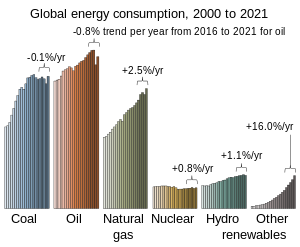User:Clayoquot/Clean energy 2
Clean energy
[edit]
Renewable energy is key to limiting climate change.[2] Fossil fuels accounted for 80% of the world's energy in 2018. The remaining share was split between nuclear power and renewables (including hydropower, bioenergy, wind and solar power and geothermal energy).[3] Solar panels and onshore wind are now among the cheapest forms of adding new power generation capacity in many locations.[4] Renewables represented 75% of all new electricity generation installed in 2019, nearly all solar and wind.[5] Other forms of clean energy, such as nuclear and hydropower, currently have a larger share of the energy supply. However, their future growth forecasts appear limited in comparison.[6]
To achieve carbon neutrality by 2050, renewable energy would become the dominant form of electricity generation, rising to 85% or more by 2050 in some scenarios. Investment in coal would be eliminated and coal use nearly phased out by 2050.[7][8]
Electricity would also need to become the main energy source for heating and transport.[9] In transport, emissions can be reduced fast by a switch to electric vehicles.[10] Public transport and active transport (cycling and walking) also produce less CO2.[11] For shipping and flying, low-carbon fuels can be used to reduce emissions.[10] Heating would be increasingly decarbonised with technologies like heat pumps.[12]
There are obstacles to the continued rapid growth of clean energy, including renewables. For wind and solar, there are environmental and land use concerns for new projects.[13] Wind and solar also produce energy intermittently and with seasonal variability. Traditionally, hydro dams with reservoirs and conventional power plants have been used when variable energy production is low. Going forward, battery storage can be expanded, energy demand and supply can be matched, and long-distance transmission can smooth variability of renewable outputs.[2] Bioenergy is often not carbon-neutral and may have negative consequences for food security.[14] The growth of nuclear power is constrained by controversy around nuclear waste, nuclear weapon proliferation, and accidents.[15][16] Hydropower growth is limited by the fact that the best sites have been developed, and new projects are confronting increased social and environmental concerns.[17]
Low-carbon energy improves human health by minimising climate change. It also has the near-term benefit of reducing air pollution deaths,[18] which were estimated at 7 million annually in 2016.[19] Meeting the Paris Agreement goals that limit warming to a 2 °C increase could save about a million of those lives per year by 2050, whereas limiting global warming to 1.5 °C could save millions and simultaneously increase energy security and reduce poverty.[20]
References
[edit]- ^ Friedlingstein et al. 2019
- ^ a b United Nations Environment Programme 2019, p. 46; Vox, 20 September 2019; Sepulveda, Nestor A.; Jenkins, Jesse D.; De Sisternes, Fernando J.; Lester, Richard K. (2018). "The Role of Firm Low-Carbon Electricity Resources in Deep Decarbonization of Power Generation". Joule. 2 (11): 2403–2420. doi:10.1016/j.joule.2018.08.006.
- ^ REN21 2020, p. 32, Fig.1.
- ^ Our World in Data-Why did renewables become so cheap so fast?; IEA - Projected Costs of Generating Electricity 2020
- ^ The Guardian, 6 April 2020.
- ^ IEA 2021, p. 57, Fig 2.5; Teske et al. 2019, p. 180, Table 8.1
- ^ IPCC SR15 Ch2 2018, p. 131, Figure 2.15
- ^ Teske 2019, pp. 409–410.
- ^ United Nations Environment Programme 2019, p. XXIII, Table ES.3; Teske, ed. 2019, p. xxvii, Fig.5.
- ^ a b IPCC SR15 Ch2 2018, pp. 142–144; United Nations Environment Programme 2019, Table ES.3 & p. 49
- ^ "Transport emissions". Climate action. European Commission. 2016. Archived from the original on 2021-10-10. Retrieved 2022-01-02.
- ^ IPCC AR5 WG3 Ch9 2014, p. 697; NREL 2017, pp. vi, 12
- ^ Berrill et al. 2016.
- ^ IPCC SR15 Ch4 2018, pp. 324–325.
- ^ Gill, Matthew; Livens, Francis; Peakman, Aiden. "Nuclear Fission". In Letcher (2020), pp. 147–149. Harvc error: no target: CITEREFLetcher2020 (help)
- ^ Horvath, Akos; Rachlew, Elisabeth (January 2016). "Nuclear power in the 21st century: Challenges and possibilities". Ambio. 45 (Suppl 1): S38–49. doi:10.1007/s13280-015-0732-y. ISSN 1654-7209. PMC 4678124. PMID 26667059.
- ^ "Hydropower". iea.org. International Energy Agency. Retrieved 12 October 2020.
Hydropower generation is estimated to have increased by over 2% in 2019 owing to continued recovery from drought in Latin America as well as strong capacity expansion and good water availability in China (...) capacity expansion has been losing speed. This downward trend is expected to continue, due mainly to less large-project development in China and Brazil, where concerns over social and environmental impacts have restricted projects.
- ^ Watts et al. 2019, p. 1854; WHO 2018, p. 27
- ^ Watts et al. 2019, p. 1837; WHO 2016
- ^ WHO 2018, p. 27; Vandyck et al. 2018; IPCC SR15 2018, p. 97: "Limiting warming to 1.5 °C can be achieved synergistically with poverty alleviation and improved energy security and can provide large public health benefits through improved air quality, preventing millions of premature deaths. However, specific mitigation measures, such as bioenergy, may result in trade-offs that require consideration."
